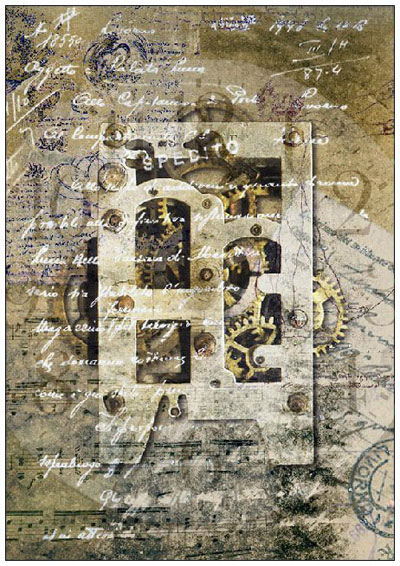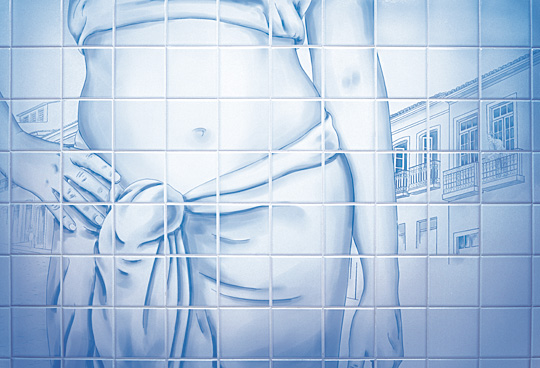
The use of architecture to establish an experience for the viewer is especially apparent in House. There is no clear hierarchy between the objects and the architecture containing them. Viewers are often confounded by their attempts to determine where and on what they should focus in his installations. Multi-tasking is a trait Pardo and most of his generation, take for granted, and the environments he creates lend themselves to multi-tasking and a multiplicity of meaning. They have the potential of existing in a variety of shapes, sizes, colors, or formats until Pardo creates the physical work. His paintings, for instance, are created on the computer and consequently exist in a suspended state. (His class at Art Center College of Design in Pasadena was the first to be given Apple computers.) The exposure to the computer radicalized his thoughts about categorization and the simultaneity of information. Pardo belongs to the first generation of artists to use computers as a tool for creating work. In each gallery, mural-sized photographs of corresponding rooms in the houses Pardo built and installation views of exhibitions create a disorienting space for viewers that oscillates between the physical space they are occupying and the space represented in the photo-mural.īy reassembling works from the past to the present in this exhibition, the artist's career becomes better defined. The work is organized and placed according to its apparent function - beds, chest of drawers, and sexy, high-heeled slippers, are arranged in the bedroom, a refrigerator and table define another gallery as the kitchen, and an architectural folly establishes another area as the garden. Jorge Pardo: House adopts the premise of a “home” in which his works are organized and presented in separate vignettes that represent various areas of a house - garden, kitchen, dining room, bedroom, etc. Instead of recreating the original installations for this museum survey, Pardo created a new context for the work that is at once familiar and disarming. As Pardo notes, "When you open up the context, you cannot control how it will be used." Other collectors and museums present these objects as art works to be looked at, but not touched. Pardo's family lives in the house in Los Angeles that he built as his solo exhibition for the Museum of Contemporary Art, Los Angeles. Installations for the Dia Art Foundation's bookstore and lobby in New York and Philadelphia’s Fabric Workshop and Museum's video lounge were designed to be used by visitors. A bedroom set Pardo designed in the 1990s, for example, furnishes a collector’s bedroom, and Pardo's lamps illuminate homes throughout the world. Some collectors use these works as functioning furniture. In most cases, these installations were dismantled after the exhibition and the individual objects were dispersed to collectors and museums. The gallery space or site itself established the framework that influenced the viewer's response.


His projects and groupings of works embodied a particular course of exploration and inquiry into the aesthetic experience that Pardo pursued at the time they were created. Pardo created most of his work for installations at galleries, museums, or specific locations. Pardo defines the objects he creates as "paintings," "drawings," and "sculpture,” but to the viewer these objects may look like a glass globe lamp, decorative tabletop, or a chair. The meaning of his work shifts according to the way it is categorized, installed and used. Pardo's work has been widely exhibited in museums, galleries and public spaces since the late 1980s, but it remains among the most difficult to define. Jorge Pardo: House is organized by the Museum of Contemporary Art, North Miami and curated by Bonnie Clearwater. These projects will be presented as photomurals at MOCA. In keeping with the genre-crossing characteristics of Pardo’s work, the exhibition will extend beyond the museum itself to encompass site-specific projects around the world, including Pardo’s own house in Los Angeles. While the works incorporate elements of minimal and Modern art, the disparity between their function and form contradicts the rules of modernism and reveals Pardo’s personal and autobiographical response to everyday objects and his environment.

Although Pardo has created large-scale projects for museums throughout the world, this is his first comprehensive U.S. Over 60 key works, including sculpture, installations, and paintings that cross the boundaries of art, design, and architecture will be presented according to their utilitarian typology in vignettes representing various rooms and areas in a house. The Museum of Contemporary Art (MOCA) will present Jorge Pardo: House, a major mid-career survey featuring the work of Jorge Pardo from Decemthrough March 2, 2008.


 0 kommentar(er)
0 kommentar(er)
